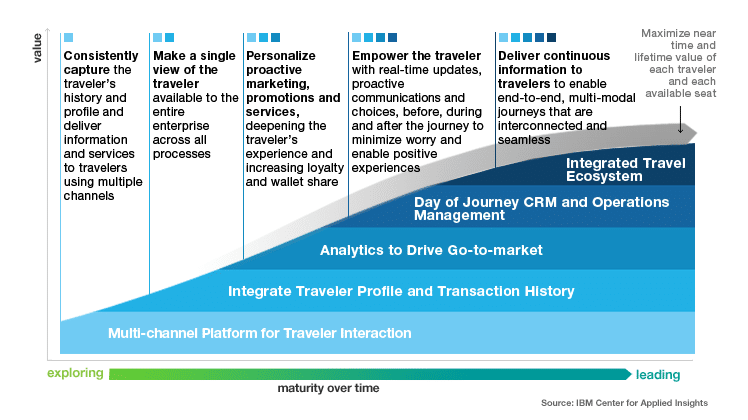 Consumers – people like you and me – are becoming channel-agnostic. They are effortlessly switching from one channel to the other. The road to purchase consists of a multitude of touchpoints across a maze of channels, media and relationships. Can marketers still keep up with consumers and, if not, why can’t they?
Consumers – people like you and me – are becoming channel-agnostic. They are effortlessly switching from one channel to the other. The road to purchase consists of a multitude of touchpoints across a maze of channels, media and relationships. Can marketers still keep up with consumers and, if not, why can’t they?
The rapid adoption of the Swiss pocketknives of the digital world, smartphones and tablets, is speeding up this emergence of a complex multichannel journey and new technologies will continue to create other buying, information gathering and media consumption patterns while the buying journey will continue to change – as it has always done – and while omnichannel shopping experiences make the borders between online and offline dissapear.
People discuss their experiences as they get in touch with a business, product and service. They share their buying decisions and actively seek the information they need – the very first step in any content marketing strategy – throughout every step of the buying journey, relying upon trusted advisors and even perfect strangers. These discussions have a huge impact on buying decisions. The shift is clear.
Yet, marketers and managers continue to struggle in keeping up with buying behavior and consumer attitude shifts, let alone in turning them into opportunities. They can barely keep up with the pace of a real-time and increasingly connected consumer. They cannot keep up with the pace of technological advancements and their adoption by consumers. And they cannot keep up with the ways in which consumers seek information and actual dialogs across their journey.
The alienation between organizations and consumers
Different reasons stand in the way of solving the continuing disconnect between organizations and customers. Some of them are technological, some are related to wrong budget allocations or an unbalanced mix, and others to disconnected processes and systems.
Challenges exist regarding internal stumbling blocks, the persistent self-absorbed thinking and the fixation on ‘our’ messages, campaigns and channels, rather than on the customer’s buying journey, digital footprints, preferences and cross-touchpoint experiences, before, during and after a purchase.
There are several ‘types’ of reasons why marketers and executives are alienated from their customers and consumers in general and are not able to turn their organization into an optimization organization that is as by definition very close to its customers, ecosystem and the touchpoints within it. Among them are certainly cultural and organizational barriers.
The cultural and organizational barriers
1. The monologue of the beautiful self
Despite what they believe, many marketers still operate in a monologue rather than a dialog mode. When taking into account preferences of consumers and “sending” messages that are highly targeted and relevant, there is nothing wrong with that. Good email marketing, for instance, still delivers high responses. However, there is a big difference between the conversion rates, let alone deliverability, of messages that are not personalized and messages with a one-size-fits-all approach. The problem is not one of channels themselves, on the contrary. People still subscribe for emails, and you should thank them for it.
The problem is one of the offer or content, that still is focused on what marketers and executives want to communicate instead of what consumers want to know, share and enjoy. It’s one of the many reasons why there are huge gaps in the customer experience. Executives can hardly resist the focus on their beautiful selves instead of on the preferences, needs and pains of consumers across their journey. We see it happening again in content marketing, for instance, where the buyer-centric dimension is often lacking. It’s perfectly possible to know what consumers want and move from monologues to dialogs. What often lacks is the sheer will to do so. Businesses that can’t let go of this self-centred approach cannot be customer-centric optimization organizations. Ask yourself: what do customers want?
2. The absence of the consumer in the organization
An increasing number of businesses recruits Chief Customer Officers. It’s our job to ensure the customer experience always comes first, regardless of division, touchpoints and context. Consistency does matter. Others connect their systems to make sure the customer is known and served in a meaningful and consistent way and now and then you do find organizations where consumers are actually involved in decision processes (e.g. by being part of a specific task force when deploying a new initiative, enabling co-creation, surveying or conducting telephone calls (as Kristin Zhivago explains in her book Roadmap to Revenue). However, most companies do not involve the customer at all. A culture of dialog requires organizations to deploy new systems, processes and even personnel. The customer experience must be watched over since it’s the flip side of the coin called conversion. So, what about people who are responsible for optimization and incentivized directly based on their results of improving conversion rates and thus improving customer experiences as Bryan Eisenberg advocates, for instance? Customer-facing decisions are seldom taken by a team but often based on what we know as the HiPPO: the Highest Paid Person’s Opinion instead of those that know the customers best. As said, actually involving customers and consumers in the strategic decision process is even more rare.
3. A big bad wolf called reputation and feedback: the nightmare of the C-suite
 I wonder if this is a personal finding or not (let me know), but it strikes me that especially top managers are uncomfortable about dialogs, gathering feedback and opening the doors of their businesses in a transparent and conversational way. It seems as if the sacred core values and the mighty brand must be shielded and protected at any cost. Don’t get me wrong: branding is key and as a brand you need to take a stand but you also let go of it and connect it with your target audiences.
I wonder if this is a personal finding or not (let me know), but it strikes me that especially top managers are uncomfortable about dialogs, gathering feedback and opening the doors of their businesses in a transparent and conversational way. It seems as if the sacred core values and the mighty brand must be shielded and protected at any cost. Don’t get me wrong: branding is key and as a brand you need to take a stand but you also let go of it and connect it with your target audiences.
Do top execs rely too much on dashboards, input from other managers and sales numbers? If top managers fear the uncertainty and unpredictability of ongoing dialogs and gathering customer feedback, then how can they get this into their corporate DNA? Managers fear the voice of the customer, especially since it’s gone public, and want to protect their reputation, clinging to the old rules of positioning as a dictatorial act of wanting to be perceived the way they decide. The result is a huge disconnect with the consumer and trust issues since they talk the talk but rarely walk the walk.
4. The quick win mania
Despite all the possibilities to do it otherwise, most organizations mainly remunerate managers and employees based on time and direct results, rarely or never based on optimizing customer satisfaction, conversions or experiences before and after the buy. And this although satisfaction leads to sales, both on the long and short run via, among others, word of mouth, one of the cheapest ways to incremental sales and essential in speeding up the route to purchase.
On top of that, managers are always under pressure to deliver fast results. This leads to an obsession with acquisition and quick wins while the foundations of future business, great customer experiences, are being forgotten. Focusing on the quick wins and overemphasizing acquisition often results in poor retention and loyalty efforts, low optimization budgets, high churn rates and bad customer experiences.
5. The far reaching impact of silos
Finally, one I mentioned before and will keep repeating: organizations continue operating in silos. It’s a mentality that is hard to change, partially since it is related to human factors (territorial struggles and egos, for instance) and partially since it responds to the comforting need of categorizing and translating complex realities into charts that respond to the fear of leaving the comfort zone of the corporate ivory tower instead of ‘getting out there’ and actually listening to customers.
Silos are the death of everything that we can call social. However, they also are destructive for a customer-centric approach and a close relationship and ongoing dialog with the customer. Silos can exist and they have a reason but, even if sometimes they can make sense, it’s key to work through them.
Furthermore, the internal silos and organizational structures are regularly ‘visible’ to the consumer, leading to poor customer experiences (lack of collaboration and follow-up) and thus bad marketing and business.
In online marketing, for instance, the organizational structure is often reflected in the navigational structure of websites, leading to failing user experiences and thus conversions as Gerry McGovern always shows when looking at task-based and customer-centric online experiences. As Gerry says: “the customer is dictator”.
He’s right. To keep up with consumers is all about customer-centric marketing, sales, culture, service, management, leadership and organization offering the right stuff on the right moment (and only then a matter of using the proper marketing software).


